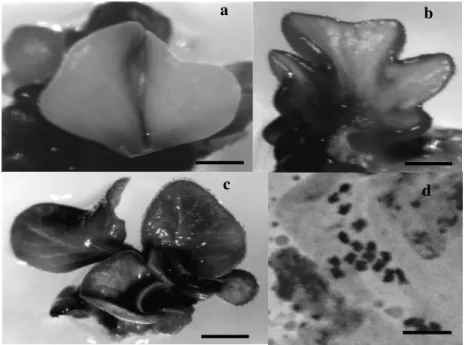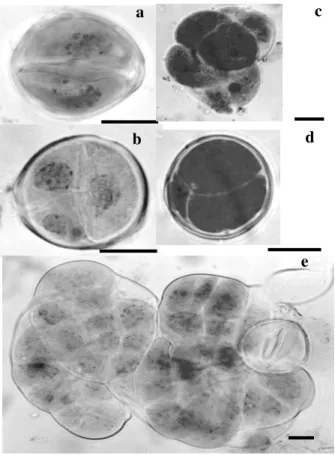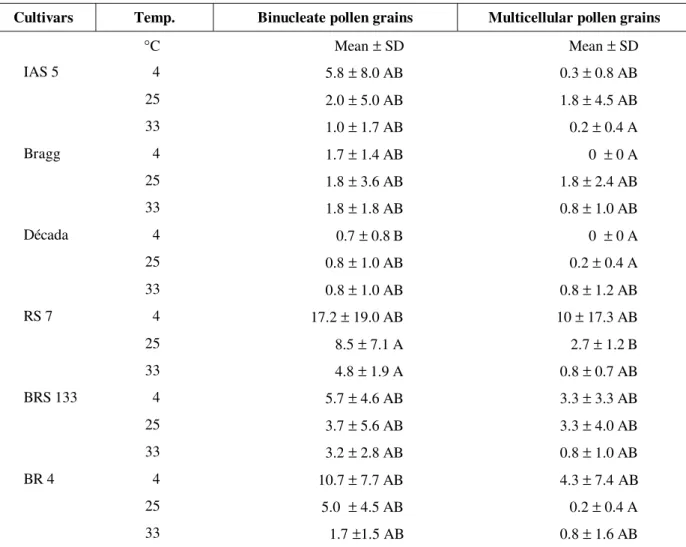Vol.47, n. 4 : pp. 537-544, August 2004
ISSN 1516-8913 Printed in Brazil
BRAZILIAN ARCHIVES OF
BIOLOGY AND TECHNOLOGY
A N I N T E R N A T I O N A L J O U R N A L
Effect of Temperature Shock on Soybean Microspore
Embryogenesis
Ana Paula de Moraes
1, Maria Helena Bonadese-Zanettini
1, Sídia Maria Callegari-Jacques
2and Eliane Kaltchuk-Santos
1∗1 Departamento de Genética; Universidade Federal do Rio Grande do Sul; eliane.kaltchuk@ufrgs.br; C. P. 15053;
91501-970; Porto Alegre - RS - Brazil. 2 Departamento de Estatística; Universidade Federal do Rio Grande do Sul;
Porto Alegre - RS - Brazil
ABSTRACT
In this study the effect of cold and heat shock on androgenetic induction in soybean anther culture was tested. Anthers of soybean were subjected to 4 and 33ºC, while the anthers used for control were maintained at 25ºC. Cytological analysis done during the 30 days of culture showed that frequencies of symmetrical binucleated and multicellular pollen grain did not differ among temperature treatments. Multicellular pollen grain could be formed by symmetrical division, as well as by assymetrical division. In relation to the embryo induction, the results of the treatments did not differ too. These results suggested that these treatments did not induce a sporophytic pathway in soybean.
Key words: Anther culture, soybean, androgenesis, symmetrical mitosis, temperature shock, stress
∗ Author for correspondence
INTRODUCTION
The formation of embryos and haploid plants from microspores represents a fundamental switch in development from normal gametophytic to sporophytic pathway. This phenomenon in which microspores change their ontogenetic route is called androgenesis and it was firstly reported by Guha and Maheshwari (1964). These researchers verified the formation of embryos on surface of
cultured anthers of Datura innoxia. Since then,
microspore embryogenesis has been reported in more than 200 species of angiosperms (Indrianto
et al., 1999). Double haploid plants obtained from
anther culture are increasingly used in plant breeding for production of homozygous lines, but its application has been limited in many species
mainly because androgeneticmechanism is largely
unknown.
Inductive stress treatment has been identified as the major trigger in inducing microspore and pollen grain embryogenesis for many plants. This inductive stress treatment has an influence in the first sporophytic mitosis. Studies have shown that
in several species the first division is symmetrical
in androgenetic embryos (Fan et al. 1988; Zaki and Dickinson, 1990, 1991, 1995). According to these authors, symmetrical division is a key step to subsequent pollen embryogenesis.
Then, pollen grains follow rapid cell divisions and
colchicine. Heat shock has been reported to increase the embryogenic route in several plants
like wheat (Touraev et al., 1996c), tobacco
(Touraev et al., 1996a and 1996b) and Brassica (Telmer et al., 1995; Binarova et al., 1997; Custers et al., 1994) while the cold shock and starvation induced microspore embryogenesis in maize,
wheat, barley and rice (Indrianto et al., 1999).
The developmental stage of microspore at the time of culture initiation is of crucial importance, with late vacuolated microspore to early bicellular pollen grain being the responsive stages to heat stress (Pechan and Keller, 1988). Since not all microspores respond to the inductive treatment, the cultures always contain a high percentage of gametophytic pollen grain.
This paper reports the effect of two inductive stress treatments, cold (4°C) and heat (33°C) shock, in six soybean cultivars. The formation of embryo-like structure and cytological characteristics were observed.
MATERIAL AND METHODS
Plant material
Soybean (Glycine max (L.) Merrill; 2n=40)
cultivars IAS 5, Bragg, Década, RS 7, BR 4, and BRS 133 field-grown were used as a source of inflorescences.
Anther culture
Floral buds of 3.0-3.5 mm in length containing uninucleate microspores were collected and kept at 4°C for 12h. The surface of the buds was sterilized with 70% ethanol for 30s, 2% NaOCl solution with a trace amount of detergent for 12 min and then rinsed three times in sterile distiled water.
Embryo induction
Anthers were cultured in induction medium I - B5
basal medium (Gamborg et al., 1968) enriched
with 16 organic compounds - supplemented with Yeung’s amino acids (Yeung and Sussex, 1979),
9% sucrose, 0.25% Phytagel, 2.0mgL-1 2,4-D and
0.5 mgL-1 BAP. For each cultivar, eighteen small
Petri dishes with induction medium I were used, six dishes for treatment (4, 25 and 33°C). Six cultivars were used, totalizing 36 dishes in each temperature. Fifty-five anthers were inoculated for dish. The dishes were incubated during four days in the dark. After this period, the cultures were
maintained at 25°C under 16h photoperiod of 22.5 µmol.m-2.s-1 provided by fluorescent light and subcultured every 4 weeks. After 8 weeks, the anthers were transferred to an induction medium II
(medium I with 1.0 mgL-1 2,4-D and 1.0 mgL-1
BAP) with a subculture on the same fresh medium every 4 weeks.
Embryos maturation
On the 75th day, half of embryogenic calli were
transferred to MSM6 (Finer and McMullen, 1991) and the other half, to induction medium II. After 30 days, calli and embryos were counted, separated, and the histodifferentiated transferred to MSO (MS salts, B5 vitamins, 3% sucrose, 0.25%
Phytagel, pH 5.8) medium.
In vitro Analysis
After 60 days of culture the anthers were classified into three classes: no responsive anthers, rough calli and embryogenic calli (green, smooth and bright calli).
Cytological Analysis
Five anthers per Petri dish were fixed in ethanol:glacial acetic acid (3:1) at 0, 15 and 30 days of culture for cytological analysis. The anthers were squashed in propionic carmine on glass slides and sealed under cover slips with bee’s wax. Microspores were staged and classified under a Zeiss Axioplan Universal microscope.
Statistical Analysis
RESULTS
Embryogenic and total calli formation
The number of embryogenic as well as of total (rough plus embryogenic) calli formed in each Petri dish was avaliated for each treatment (N=36), not matching distinction among cultivars (Table 1). The avarege number of embryogenic calli varied from 2.7 to 4.1, but the differences among temperatures were not statistically significant (χ2KW=4.251; df=2; p=0.119). The avarege for the total calli formation did not vary among
temperatures either (χ2KW=1.423; df=2; p=0.49).
On the other hand, significant differences, independent of treatment, were found both for the
number of embryogenic (χ2KW=32.251; df=5;
p<0,001) and the total (χ2KW=14.517; df=5;
p=0.013) calli produced. BRS 133 showed the lowest induction frequency of embryogenic calli in comparison with other cultivars (Fig. 1). The same
pattern, however, was not observed for the total calli production: BR 4 produced significantly more calli than IAS 5 and Bragg; the other cultivars did not present statistical differences in relation to these three cultivars (Fig. 2).
The embryos formed until the 60th day of culture
showed high variability in their morphology during development. Many embryos were partially or completely fused (Fig. 3). Several of these embryos were not able to develop into a plantlet and just a small number survived in culture during many months. These structures were maintained in the MSO, nevertheless, part of them eventually blackened and died. When transferred into MSO medium containig 1% sucrose, the plantlets further developed. A complete plantlet with leaves was
observed after the 80th day of culture (Fig. 3c).
Chromosome counts in this plantlet showed the expected haploid (2n=20) condition (Fig. 3d).
Table 1: Avarege (± standard deviation) number of embryogenic and total calli formed by soybean anthers (six cultivars) mantained at three different temperature conditions (N=36 dishes for treatment).
Temp. Number of embryogenic calli Number of total calli formation
°C Avarege ± SD Avarege ± SD
4 2.9 ± 3.5 29.3 ± 4.3
25 4.1 ± 2.9 29.9 ± 3.6
33 2.7 ± 2.0 29.2 ± 4.4
Figure 1 - Avarege number (N=18) of embryogenic calli produced per cultivar, on the 60th day of culture. Avarege followed by the same letter do not differ significantly (a=0,05).
0 0,5 1 1,5 2 2,5 3 3,5 4 4,5
A
varege number
of
embryogenic calli
IAS 5 Bragg RS 7 BRS 133 BR 4
cultivars
a
a
a
a
a
Figure 2 - Avarege number (N=18) of total calli produced per cultivar, on the 60th day of culture. Avarege followed by the same letter do not differ significantly (a=0,05).
Figure 3 - Structures formed in culture: a and b - fused cotyledons (bars=1 mm), c- plantlet formed from embryo (bar=1 cm), d- haploid cell with 2n=20 (bar=10µm).
Cytological analysis
In order to investigate whether a heat or a cold shock treatment would be effective to induce the formation of binucleated symmetrical and multicellular pollen grains in soybean (Fig. 4),
both with androgenetic potential, two 3x3x6 factorial analysis of variance was performed. Two and three factor interactions were considered besides the main effects temperature, days of culture and cultivars. As the three factors a
c
b
d
0 10 20 30 40 50 60 70 80
IAS 5 Bragg RS 7 BRS 133 BR 4
A
v
a
reg
e n
u
m
b
er o
f
to
ta
l
ca
ll
i
Cultivars
a,b
b
a,b
a,b
b
interaction was statistically significant for both variables (F= 4.91, p<0.0001 and F=1.91, p=0.014 for symmetrical and multicellular pollen grains, respectively), treatments could not be compared without considering cultivars and days of culture. Therefore, the effects of cultivars and temperature (as well as its interactions) were analysed at each day of culture separately.
Differences were detected only at day 15 of culture for symmetrical binucleated and multicellular pollen grains (Table 2). Cultivar RS
7 incubated at 25 and 33°C showed more symmetrical binucleate pollen grains than Década incubated at 4°C, other differences being not significant. For multicellular pollen grains, RS 7 incubated at 25°C showed higher frequencies of multicellular pollen formation than Bragg/Década incubated at 4°C, IAS 5 (33°C) and Década/BR 4 incubated at 25°C, which presented the same average number of multicellular pollen grains (0-0.2).
Figure 4 - Symmetrical and multicellular soybean pollen grains. a- symmetrical pollen grain; b, c and e- multicellular pollen grain; d- multicellular pollen grain with two vegetative and one generative cell. (bars=10µm).
a
b d
Table 2 - Average (± standard deviation; N=6) of the number of binucleated and multicellular pollen grains at day 15 of culture.
Cultivars Temp. Binucleate pollen grains Multicellular pollen grains
°C Mean ± SD Mean ± SD
IAS 5 4 5.8 ± 8.0 AB 0.3 ± 0.8 AB
25 2.0 ± 5.0 AB 1.8 ± 4.5 AB
33 1.0 ± 1.7 AB 0.2 ± 0.4 A
Bragg 4 1.7 ± 1.4 AB 0 ± 0 A
25 1.8 ± 3.6 AB 1.8 ± 2.4 AB
33 1.8 ± 1.8 AB 0.8 ± 1.0 AB
Década 4 0.7 ± 0.8 B 0 ± 0 A
25 0.8 ± 1.0 AB 0.2 ± 0.4 A
33 0.8 ± 1.0 AB 0.8 ± 1.2 AB
RS 7 4 17.2 ± 19.0 AB 10 ± 17.3 AB
25 8.5 ± 7.1 A 2.7 ± 1.2 B
33 4.8 ± 1.9 A 0.8 ± 0.7 AB
BRS 133 4 5.7 ± 4.6 AB 3.3 ± 3.3 AB
25 3.7 ± 5.6 AB 3.3 ± 4.0 AB
33 3.2 ± 2.8 AB 0.8 ± 1.0 AB
BR 4 4 10.7 ± 7.7 AB 4.3 ± 7.4 AB
25 5.0 ± 4.5 AB 0.2 ± 0.4 A
33 1.7 ±1.5 AB 0.8 ± 1.6 AB
Means followed by the same letter do not differ significantly (α=0,05).
DISCUSSION
Data obtained in the present study showed that embryogenic calli formation obtained after 4 days at 4 and 33°C did not differ from the control. Keller and Armstrong (1979) tested a treatment at
30 and 35°C in Brassica campestris. The first
treatment decreased embryo yield, but the second stimulated the frequency of embryogenesis.
Smýkal (2000) showed that in B. napus, two
conditions were important to trigger
embryogenesis: a) in vitro temperature should be
near to the physiological limit of the plant and
b) temperature of microspores in vitro should be
10-12°C higher than the temperature of donor plant. In the present study, only one high temperature, 33°C, was tested which might not be sufficiently elevated to increase the frequency of embryogenesis. In spite of a great variability in the
morphology of embryos formed in vitro, they
resembled the somatic ones induced in high 2,4-D medium from immature cotyledons
(Buchheim et al., 1989; Santos, 1997). A previous
study showed that putative androgenetic embryos of soybean were histologically similar to zygotic embryos (Kaltchuk-Santos et al., 1997).
According to some authors, induction of cell division is an independent process in the determination of embryogenesis. Touraev et al. (1996a) showed that multicellular structures could be formed after asymmetric mitosis indicating that
symmetry of microspore in vitro is not essential
and/or multicellular pollen grains formation in soybean, since it detected interactions between cultivars, treatments and days of culture.
ACKNOWLEDGEMENT
This study was supported in part by CNPq, FAPERGS and PROPESQ.
RESUMO
Neste estudo foram testados os efeitos do choque térmico na indução androgenética em cultura de anteras de soja. Parte das anteras formam submetidas ao choque térmico de 4 ou 33°C, enquanto as anteras controle formam mantidas a 25°C. Análises citológicas formam realizadas ao longo dos 30 primeiros dias de cultura mostrando que a freqüência de grãos de pólen binucleados simétricos e multinucleados não difere entre os tratamentos e que os grãos de pólen multinucleados podem ser formados tanto a partir de uma mitose simétrica inicial como após uma mitose assimétrica. Em relação à indução embriogênica, os tratamentos também não diferem. Estes resultados sugerem que o tratamento de choque térmico não induz a rota esporofítica nos micrósporos de soja.
REFERENCES
Binavora, P.; Hause, G.; Cenklová, V.; Cordewener, J. H. G. and; Van Lookeren Campagne, M. M. (1997), A short severe heat shock is required to induce embryogenesis in late bicellular pollen of Brassica
napus L. Sex. Plant Reprod.,10, 200-208.
Buchheim, J. A.; Colburn, S. M. and Ranch, J. P. (1989), Maturation of soybean somatic embryos and the transition to plantlet growth. Plant Physiol., 89, 768-775.
Custers, J. B. M.; Cordewener, J. H. G.; Nöllen, Y.; Dons, H. J. M. and van Lookeren Campagne, M. M. (1994), Temperature controls both gametophytic and sporophytic development in microspore culture of
Brassica napus. Plant Cell Reports, 13, 267-271.
Fan, Z.; Armstrong, K. C. and Keller, W. A. (1988), Development of microspores in vivo and in vitro in
Brassica napus L. Protoplasma, 147, 191-199.
Finer, J. J. and McMullen, M. D. (1991), Transformation of soybean via particle bombardment of embryogenic suspension culture tissues. In Vitro
Cell. and Developmental Biology, 27P, 175-182.
Gamborg, O. L.; Miller, R. A. and Ojima, K. (1968), Nutrient requirements of suspension culture of soybean root cells. Exp. Cell. Res., 50, 151-158. Guha, S. and Maheshwari, S. C. (1964), In vitro
production of embryos from anthers of Datura.
Nature, 204, 497.
Indrianto, A; Herbele-Bors, E. and Touraev, A. (1999), Assessment of various stresses and carbohydrates for their effect on the induction of embryogenesis in isolated wheat microspores. Plant Science, 143 : (1), 71-79.
Kaltchuk-Santos, E.; Mariath, J. E.; Mundstock, E. and Zanettini, M. H. B. (1997), Cytological analysis of early microspore divisions and embryo formation in cultured soybean anthers. Plant Cell, Tissue and
Organ Culture, 49, 107-115.
Keller, W. A. and Armstrong, K. C. (1979), Stimulation of embryogenesis and haploid production in Brassica
campestris anther cultures by elevated temperature
treatments. Theorical and Applied Genetics, 55, 65-67. Pechan, P. M. and Keller, W. A. (1988), Identification of potentially embryogenic microspores in Brassica
napus. Physiol. Plant, 74, 377-384.
Santos, K. G. B. (1997), Embriogênese somática em soja (Glycine max (L.) Merrill): efeito do genótipo, do etileno e ontogenia dos embriões. Dissertação (Mestrado em Genética), Universidade Federal do Rio Grande do Sul, Rio Grande do Sul, Brasil. Smýkal, P. (2000), Pollen embryogenesis - the stress
mediated switch from gametophytic to sporophytic development. Current status and future prospects.
Biologia Plantarum, 43 : (4), 481-489.
Telmer, C. A., Newcomb, W. and Simmonds, D. H. (1995), Cellular changes during heat shock induction and embryo development of cultured microspores of
Brassica napus cv. Topas. Protoplasma, 185, 106-112.
Touraev, A.; Ilham, A.; Vicente, O. and Heberle-Bors, E. (1996a), Stress as the major signal controlling the developmental of tobacco microspores: towards a unified model of induction of microspore/pollen embriogenesis. Planta, 200, 144-152.
Touraev, A.; Ilham, A.; Vicente, O. and Heberle-Bors, E. (1996c), Stress-induced microspore embryogenesis in tobacco: an optimized system for molecular studies. Plant Cell Reports, 15, 561-565.
Touraev, A.; Indrianto, A.; Wratschko, I.; Ilham, A.; Vicente, O. and Heberle-Bors, E. (1996b), Efficient microspore embryogenesis in wheat (Triticum
aestivum L.) induced by starvation at hight
temperature. Sex. Plant Reprod., 9, 209-215.
Yeung, E. C. and Sussex, I. M. (1979), Embryogeny of
Phaseoleus coccineus: the suspensor and the growth
Zaki, M. A. M. and Dickinson, H. G. (1990), Structural changes during the first divisions of embryos resulting, from anther and free microspore culture in
Brassica napus. Protoplasma, 156, 149-162.
Zaki, M. A. M. and Dickinson, H. G. (1991), Microspore-derived embryos in Brassica: the significance of division symmetry in pollen mitosis I to embryogenic development. Sex. Plant Reprod., 4, 48-55.
Zaki, M. A. M. and Dickinson, H. G. (1995), Modification of cell development in vitro: the effect of colchicine on anther and isolated microspore culture in Brassica napus. Plant Cell, Tissue and
Organ Culture, 40, 255-270.
Zar, J. H. (1999), Biostatistical Analysis. New Jersey : Prentice Hall.



